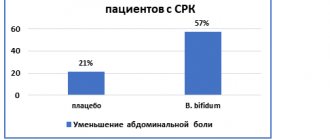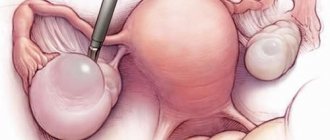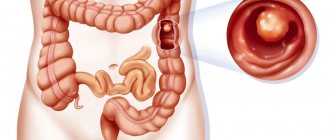PMS symptoms, known as premenstrual syndrome, begin 5-14 days before your period begins. Here are 10 main signs that a woman experiences during this period. You can deal with most of them at home. But if the manifestations are too active and affect your life and interfere with you, be sure to discuss this with your gynecologist.
PMS symptoms
Treating PMS Symptoms
More than 90 percent of women experience PMS symptoms to some degree. They usually go away in the first two days after the start of menstruation. We publish the 10 most common signs that your period is approaching.
Causes
The exact cause of PMS has not been established. There is a correlation of the syndrome with a lack of body weight, high intellectual and psycho-emotional stress in patients. More often, premenstrual syndrome is observed in women who have suffered hormonal fluctuations (abortion, childbirth) with pathology of the heart and blood vessels, digestive organs or central nervous system.
There are several hypotheses about the origin of PMS:
- Hormonal. It is believed that the syndrome can be triggered by improper conversion of progesterone (to pregnenolone, an antagonist of A- and B-GABA receptors). The influence of corticosteroids and male hormones (androstenedione and testosterone) on the course of PMS is considered.
- Hypersensitivity hypothesis. Based on an allergic reaction to estrogens in the LH phase of the ovarian cycle.
- "Water intoxication." It is suggested that there is a connection between changes in the regulation of the renin-angiotensin-aldosterone system (RAAS; with increased ACTH secretion) and tissue fluid retention in women with PMS.
- Neurotransmitter imbalance of the pituitary-hypothalamic system. The modern concept considers an increase in melanostimulating hormone (MSH). By binding to endorphins and sex steroids, it can provoke high concentrations of vasopressin, prolactin, emotional lability and increased appetite.
How to treat PMS?
Contact your gynecologist to relieve your PMS symptoms. The doctor will tell you how to deal with unpleasant sensations before menstruation and not harm women’s health after collecting an anamnesis and gynecological examination of the patient. Based on the examination results, the doctor makes a diagnosis of PMS. The gynecologist gives an explanation of the regimen for taking prescribed medications. Do not self-medicate so as not to worsen the situation.
To treat PMS use:
- medications (painkillers, antidepressants, diuretics);
- hirudotherapy (treatment with leeches);
- aerobic physical activity (cardio exercise), in which oxygen serves as the source of energy to maintain muscle function;
- diet (gradual transition to a healthy menu, avoiding excessive consumption of caffeine, salt and sugar two weeks before the start of menstruation).
Anecdotal research suggests that certain vitamins and minerals may help relieve menstrual discomfort. These include calcium, magnesium, vitamin B6, polyunsaturated fatty acids (omega). However, the Food and Drug Administration (FDA) does not recommend unauthorized use of vitamin complexes and supplements, as this can cause menstrual dysfunction. Before taking them, you should consult your doctor.
You also need to give up bad habits (smoking, drinking alcohol), avoid stressful situations, yoga and meditation, massage are recommended. According to the study, women who smoke reported more PMS symptoms than non-smokers. Problems in the family and at work, lack of sleep, and restless sleep can aggravate the situation. Women's periods should be regular and not cause significant harm to women's well-being and health. A gynecologist will help solve problems with the menstrual cycle and prevent dysfunction of the ovaries and other female genital organs.
1
1
6
Article rating:
4.11 out of 5 based on 9 ratings
Author: Filatova Tatyana Sergeevna
Obstetrician-gynecologist. First category. Work experience over 18 years.
Symptoms
Premenstrual syndrome affects several systems in the body:
- In terms of the psycho-emotional sphere, patients complain of frequent mood swings, depression, excessive irritability and tearfulness.
- Disturbances in the functioning of the autonomic nervous system and blood vessels are expressed in surges in blood pressure, cranialgia (headaches), cardialgia (pain in the heart), nausea (even vomiting).
- Common metabolic signs include breast enlargement and engorgement, itching, hyperthermia, and body edema.
Based on the dominance of a certain group of symptoms in the clinical manifestations, 4 main types of PMS are distinguished:
- Edema
(with increased aldosterone). It manifests itself as swelling of the legs, face, abdominal cavity, and bloating. - Neuropsychic
(against the background of high concentrations of estrogen and low concentrations of progesterone, or excess androgens). Anxious experiences, irritability (estrogens), or a depressive state, apathy, sleep disorders, forgetfulness (androgens) occur. Hypersensitivity to smells and sounds is also characteristic, and in adolescents - aggressiveness. - Cephalgic
(associated with increased secretion of prostaglandins, often combined with increased appetite). Women are worried about a migraine-like condition: headache (severe, throbbing, in the temple area, sometimes radiating to the eye), nausea, hyperhidrosis, breast engorgement, dizziness, severe sensitivity to sounds and smells. - Crisis
(against the background of changes in blood pressure against the background of changes in the sympathoadrenal system). Hypertension occurs (sometimes an increase in pressure of 10-20 mm Hg is enough), palpitations, fear of death, and a feeling of pressure behind the sternum. Due to the centralization of the blood supply, coldness and numbness in the extremities are observed. The crisis ends with increased diuresis.
The forms described above are most common, but in addition to them, there are 4 more atypical variants of the course of PMS:
- Hyperthermic
- accompanied by a rise in temperature in the LH phase of the menstrual cycle (MC). - Hypersomnic
- excessive drowsiness occurs in the lutenic phase. - Ophthalmoplegic
- before menstruation, muscle weakness of half the body and unilateral drooping of the eyelid are noted. - Cyclic allergic manifestations
are usually observed in the form of asthma, ulcerative gingivostomatitis, menstrual migraines and iridocyclitis.
Clinical division classifies PMS into mild (up to 3-4 signs 2-10 days before CD) and severe (5-12 manifestations 3-14 days before CD) forms.
Make an appointment
Make an appointment with a urologist by calling 8(812)952-99-95 or filling out the online form - the administrator will contact you to confirm your appointment
guarantees complete confidentiality
Treatment of premenstrual syndrome
Treatment of premenstrual syndrome is mainly symptomatic, and depends on the prevailing symptoms.
First of all, it is recommended to introduce some restrictions in the diet - reducing carbohydrates, salt, liquid, animal fats, alcohol in the second phase of the cycle, increasing the amount of fruits and vegetables consumed.
It is necessary to reduce psycho-emotional stress, increase rest time, and light physical exercise in the fresh air.
In complicated cases the following may be prescribed:
- Symptomatic therapy – antidepressants, antipsychotics, diuretics, analgesics
- Vitamin therapy – vitamins B, A and E, magnesium, herbal and homeopathic preparations (for mild forms of premenstrual syndrome)
- Drug therapy. Medicines for the treatment of premenstrual syndrome are prescribed when other measures are ineffective. In this case, combined oral contraceptives are mainly chosen, which are aimed at inhibiting ovulation, normalizing hormone concentrations and regulating the cycle.
Important!!!
Self-medication and the use of various medications on your own only temporarily help reduce the manifestations of premenstrual syndrome. In the absence of qualified consultation with a specialist and his supervision, PMS can develop into complicated stages. In addition, competent correction of the menstrual cycle is mandatory for women planning pregnancy.
In our clinic, you can make an appointment with a qualified specialist - a gynecologist, who will answer your questions, conduct an examination and, if necessary, select the right treatment.
Stages
According to the dynamics of its course, premenstrual syndrome is divided into the following stages:
- Compensated
. Signs of PMS appear in the LH phase of the cycle and disappear with the onset of KD without progression of symptoms over time. - Subcompensated
. Manifestations of PMS disappear 1-3 days after the onset of CD and worsen over the years. - Decompensated
. Symptoms persist throughout the CD, sometimes remaining after completion; their obvious strengthening over time and a reduction in “light gaps” are noted.
TREATMENT OF PREMENSTRUAL SYNDROME IS AVAILABLE IN THE BRANCHES:
Treatment of premenstrual syndrome in the Primorsky region
Address: St. Petersburg , Primorsky district, st. Repisheva, 13
Treatment of premenstrual syndrome in the Petrograd region
Address: St. Petersburg , Petrogradsky district, st. Lenina, 5
Treatment of premenstrual syndrome in Vsevolozhsk
Address: Vsevolozhsk , Oktyabrsky Prospekt, 96 A
Diagnostics
Often, signs of PMS are regarded as a separate somatic disease, and therefore, the doctor may take the improvement of a woman’s condition in the FSH phase as a result of treatment. The main parameters studied when diagnosing PMS:
- Identifying the cyclical nature of symptoms. It is advisable for a woman to keep a diary of her health and note the days when signs of PMS began, its symptoms and the day they stopped.
- Neurological diseases are excluded using EEG and rheoencephalography of cerebral vessels.
- The severity of endocrine imbalance is determined using blood tests for PGE 2, progesterone and prolactin on the eve of and upon the onset of critical days.
- In case of a neuropsychiatric form, craniography and consultation with a neurologist and psychiatrist are additionally prescribed.
- The edematous form of the syndrome can be determined by monitoring the daily amount of urine (normally, 300-400 ml more than what is drunk is excreted) several days before and upon the onset of critical days, mammography and a blood test for residual creatinine and nitrogen.
- The cephalgic form requires consultation with an ophthalmologist and neurologist, additional examination of the fundus and radiography of the cranial vault.
- The crisis form is determined by craniography and blood pressure monitoring.
How to get rid of irritability during PMS?
To get rid of irritability a week before or during menstruation, you need to undergo treatment with a gynecologist. Irritability is one of the characteristic psycho-emotional symptoms of PMS. Temperature, pain and other physiological sensations increase the manifestation of psycho-emotional disorders. Without the help of a doctor, it is impossible to control hormone levels and associated PMS symptoms. How many days in advance you need to take the prescribed medications depends on how pronounced the discomfort is and how often it bothers you. In most cases, irritability is accompanied by anger, anger, or a feeling of increased anxiety. Depending on the stability of the emotional state, a woman may be prescribed broad-spectrum sedatives.
Healthy food (normalizes blood sugar levels, improves metabolism) and regular physical activity (maintains muscle tone) help maintain a good mood and well-being during irritability. In order not to aggravate the manifestation of irritability, it is necessary to avoid caffeinated drinks and other stimulants.
Cost of treatment of premenstrual syndrome:
| Services list | Price in rubles | |
| Saint Petersburg | Vsevolozhsk | |
| Initial appointment with a 1st stage obstetrician-gynecologist | 1850 | 1500 |
| Repeated appointment with a 1st stage obstetrician-gynecologist | 1650 | 1300 |
| Primary appointment with an obstetrician-gynecologist, stage 2 | 2100 | — |
| Repeated appointment with an obstetrician-gynecologist, stage 2 | 1900 | — |
| MANIPULATION | ||
| Insertion of obstetric pessary | 1500 | 1500 |
| Insertion of an intrauterine device (IUD) | 2500 | 2500 |
| Insertion of the Mirena intrauterine device | 4000 | 4000 |
| Introduction of the implantable contraceptive IMPLANON (without the cost of the contraceptive) | 2500 | 2100 |
| Videocolposcopy | 1700 | 1700 |
| Smear collection (gynecological) | 400 | 400 |
| Instrumental removal of the intrauterine device (IUD) | 2500 | 2100 |
| Intravaginal administration of suppositories (without the cost of medications), 1 procedure | 500 | 500 |
| Therapeutic treatment of the vagina | 700 | 700 |
| Medical termination of pregnancy | 8000 | — |
| Local treatment of the external genitalia | 700 | 700 |
| Removing the obstetric pessary | 1000 | 1000 |
| Removing the intrauterine device (IUD) | 1500 | 1500 |
| Removal of the Mirena intrauterine device | 3000 | 3000 |
| Removal of the implantable contraceptive IMPLANON | 2500 | 2300 |
| Removing a foreign body from the vagina | 1800 | 1800 |
| Line biopsy of the endometrium (pipe diagnostics) | 1500 | 1200 |
| PRP therapy | — | 3500 |
| ULTRASONIC AND FUNCTIONAL DIAGNOSTICS | ||
| Ultrasound of the pelvic organs (one sensor) | 1600 | 1300 |
| Ultrasound of the pelvic organs (two sensors) | 1900 | 1500 |
| CTG (fetal cardiotocography) | 1800 | — |
| CTG (multiple pregnancy) | 2300 | — |
| Folliculometry (1 study) | 1400 | 1400 |
| Folliculometry (4 studies) | 3900 | 3900 |
| LASER SURGERY | ||
| Cervical biopsy + histology | 5000 | 4000 |
| Single cervical cyst | 1500 | 1500 |
| Single papillomas and condylomas of the vaginal walls | 3000 | 3000 |
| Common condylomatosis, papillomatosis | from 6000 | from 6000 |
| Removal of single condylomas, papillomas of the vulva, cervix (for 1 unit) | 600 | 600 |
| Ectopia (erosion) of the cervix (less than 2 cm) | 6000 | 4000 |
| Ectopia (erosion) of the cervix (more than 2 cm) | 9000 | 9000 |
| Endometriosis of the cervix (single lesion) | 1000 | 1000 |
| RADIOSURGERY | ||
| Biopsy of the cervix with a radioknife | 2500 | 2000 |
| Treatment of leukoplakia and vulvar kraurosis using a radiosurgical knife | 5300 | 5100 |
| Treatment of cervical pathology with a radiosurgical knife up to 1 cm | 5000 | 3700 |
| Treatment of cervical pathology using a radiosurgical knife up to 2 cm | 6500 | 6000 |
| Removal of cervical polyps using a radiosurgical knife | 4000 | 2500 |
| Fulguration of cysts, endometrioid lesions using a radiosurgical knife | 3500 | 2200 |
| Electrocoagulation of condylomas on the skin in the perineal area with a radio knife (for 1 unit) | 800 | 800 |
| Electrocoagulation of condylomas, papillomas of the vulva with a radio knife | 1400 | 1400 |
| Electrocoagulation of condylomas, vaginal papillomas with a radio knife | from 3200 | from 3200 |
| OPERATIONS | ||
| Intimate contouring | — | 26000 |
| Surgical defloration | 8000 | 8000 |
Prevention
The following recommendations will help prevent premenstrual syndrome:
- We need to reduce stress levels and reduce its impact.
- It is important to exercise regularly throughout the month (for example, aerobics, yoga, fitness or swimming).
- It is necessary to adhere to a healthy diet.
- For those who smoke, it is important to stop smoking as it can make PMS symptoms more severe. You should also limit your consumption of coffee and alcohol.
If there are concomitant diseases, you need to be observed by doctors. If PMS is manifested mainly by changes in the emotional state, you need to regularly visit a psychotherapist. In case of edema, consultations with a therapist and nephrologist are needed. If you have a headache during PMS or have migraine-like symptoms, you need to be monitored by a neurologist. If you have high blood pressure, you should periodically consult a physician or cardiologist.
Take nutritional supplements
Daily intake of 1000 mg calcium, 50 to 200 mg vitamin B6, 150 to 300 IU vitamin E, and 200 mg magnesium during the luteal phase (second half) of the monthly cycle relieves severe PMS symptoms. Magnesium relieves muscle spasms and mood swings.
Daily calcium intake reduces bloating, cramps, and irritability. Vitamin B6 is necessary for the synthesis of steroid hormones, including progesterone and estrogens. It is also involved in the production of the neurotransmitters gamma-aminobutyric acid and serotonin and reduces high levels of estrogen, which are considered to be the cause of PMS.
Recommendations for improving the condition
There are several ways to relieve PMS symptoms:
- If you have severe pain, you can take a painkiller.
- Chocolate will help improve your mood when you are irritable or depressed.
- If there is discomfort in the lower abdomen, lightly stroking it clockwise with your palm will help. It will relieve spasm and reduce pressure on the abdominal cavity.
- To prevent your health from deteriorating, it is important to avoid heavy physical activity and get enough rest.
- Pain in the lower abdomen is felt less in the fetal position. You can lie on your side for a while, pulling your knees toward your stomach to relax your body. You can apply a warm heating pad to your stomach (but do not apply ice or anything very hot).
- You need to sleep at least 8 hours a day.
Is it possible to relieve PMS with nutrition?
A well-balanced diet helps improve overall health and well-being and reduce symptoms of PMS. It is important to adhere to a healthy diet:
- eat more protein foods and fiber;
- reduce the consumption of salt, sugar, fatty foods containing large amounts of carbohydrates;
- eat more often, in small portions;
- drink more clean water.
For severe PMS, you need to include more of the following products in your menu:
- greens, fresh vegetables, fruits;
- black chocolate;
- fish (salmon, tuna);
- olive oil;
- cereals, grain products (pearl barley, dark rice, sesame and others);
- ginger;
- turmeric;
- green tea.
To prevent PMS symptoms from getting worse, you need to eat less foods rich in simple carbohydrates (baked goods, confectionery, sweets, etc.). You also need to limit the consumption of smoked, fried and fatty foods, chips, snacks and other salty foods, alcohol, coffee and foods or drinks containing caffeine. The closer to the beginning of menstruation, the less such products should be in the diet.










